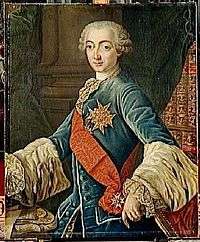Marc Antoine René de Voyer

Marc Antoine René de Voyer, Marquis de Paulmy and 3rd Marquis d'Argenson (1757) (22 November 1722, Valenciennes – 13 August 1787), was a French ambassador to Switzerland, Poland, Venice and to the Holy See; and later Minister of War. He was also a noted bibliophile and collector of art.
Biography
Marc Antoine René de Voyer was the only son of René-Louis de Voyer de Paulmy, marquis d' Argenson. He should not be confused with his grandfather, Marc-René, or his great-grandfather, also Marc-René, or in particular with his cousin Marc-René de Voyer d'Argenson (1721–1782).
In 1750 he was appointed to head the stables of King Louis XV and appointed governor of the Château de Vincennes in 1754. He served as French ambassador to Switzerland, Poland, Venice and to the Holy See. He followed his uncle, Marc-Pierre as war minister when the latter was forced from office by the influence of Madame de Pompadour in 1758.
He was a noted bibliophile and collector of art, whose private hope, reported in his memoirs[1] was to be appointed director of the Bâtiments du Roi, a post that devolved upon Mme de Pompadour's highly competent brother. He built a château at Asnières[2] in 1750, with expenses that scandalized his virtuous uncle, to set the tone for the Court and display his collection of works by Northern Renaissance masters. In the decade 1748-58 he appears repeatedly in the daybook of the marchand-mercier Lazare Duvaux, often purchasing Chinese celadon porcelains set in rococo French gilt-bronze mounts, and even bringing to Duvaux fine examples from his own collection to be mounted according to his taste.[3] He was compelled by financial troubles to sell the house in 1769.
His library was one of the finest collections of a private individual. It included some 100,000 carefully selected volumes, largely by French writers and especially poets. He catalogued the library himself, dictating or writing the documents which display his expertise and taste. The library was purchased in 1785 by the Count of Artois, brother of the king, who allowed Argenson to retain it his lifetime. This library formed the basis of the Bibliothèque de l'Arsenal since, as grand master of artillery, he had used the Arsenal to house his library.
Literary works and academic positions
He planned the Bibliothèque universelle des romans, published between 1775 and 1778 in 40 octavo volumes, a collection of novels including some of his own writing. His own novellas were published in 1782 as Choix de petits romans de différents genres. He also produced the Mélanges tirés d'une grande bibliothèque (69 volumes, 1779 to 1787) containing extracts from his library.
He was elected to the Académie française in 1748 and also to the Academy of Sciences and the Académie des Inscriptions et Belles-Lettres.
References
- ↑ Noted by Louis Courajod , Le livre-journal de Lazare Duvaux, Paris, 1873:xxxiii
- ↑ The shuttered building today, overtaken by the spread of Paris.
- ↑ Courajod 1873.
External links
- Biiographical notice on the Académie française website.
| Political offices | ||
|---|---|---|
| Preceded by Marc-Pierre de Voyer de Paulmy, comte d'Argenson |
Secretary of State for War 1757–1758 |
Succeeded by Charles Louis Auguste Fouquet de Belle-Isle |